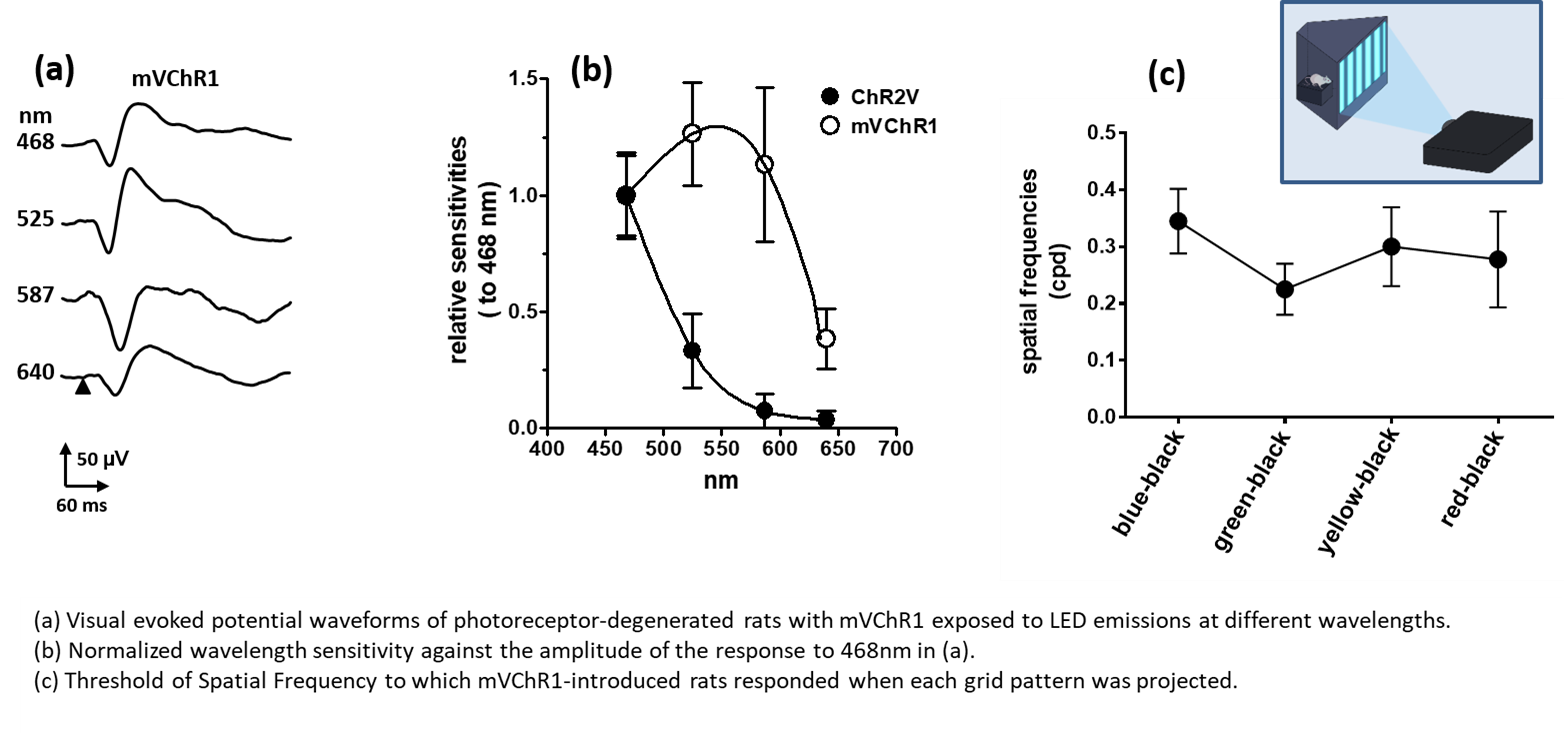It is a gene therapy that restores one’s visual acuity through transmission of visual information to the brain. It introduces photoreceptive functions to ganglion cells instead of retinal photoreceptors damaged by retinitis pigmentosa by introducing the channel rhodopsin-1 gene (mVChR1) originating the green alga Volbox.
- No need to reconstruct photoreceptor cells if the ganglion cells are maintained.
- Recognition of all spectrums from blue to red (though in black-and-white images) in high resolution.
- Single injection therapy with minimal burden on patients.
- No cancerous risk of stem cell therapies.

Patents and related papers
Patents
- Filing date:2009/8/10, PCT/JP2010/063786, Title: Light-receiving channel rhodopsin having improved expression efficiency
- Date of Patent Jun.17, 2014, Patent No: US 8,754,048B2, Title: Light-receiving channel rhodopsin having improved expression efficiency.
Papers
- Invest Ophthalmol Vis Sci. 2007 Aug;48(8):3821-6 “Visual responses in aged dystrophic RCS rats were restored by AAV-mediated channelopsin-2 gene transfer.” Tomita H, et al.,
- 臨床眼科 増刊号 網膜硝子体診療 update 医学書院, 第62巻 11号, 2008, p336-341 「チャネルロドプシン」冨田浩史 他
- PLoS ONE, November 2009, Volume 4, Issue 11, “Visual Properties of Transgenic Rats Harboring the Channelrhodopsin-2 Gene Regulated by the Thy-1.2 Promoter.” Tomita H, et al.,, Wang H, Sugiyama Y, Hikima T, Sugano E, Tomita H, Takahashi T, Ishizuka T, Yawo H
- The Journal of Biological Chemistry, 2009 Feb 27;284(9):5685-96. Epub 2008 Dec 22. “Molecular determinants differentiating photocurrent properties of two channelrhodopsins from chlamydomonas.”
- Experimental Eye Research, 2010 Mar;90(3):429-436. Epub 2009 Dec 27., “Channelrhodopsin-2 gene transduced into retinal ganglion cells restores functional vision in genetically blind rats.” Tomita H, et al.,
- Journal of Genetics, 2009 Dec;88(4):409-15. “Channelrhodopsins provide a breakthrough insight into strategies for curing blindness.” Tomita H, et al.,
- PLoS One. 2009 Nov 5;4(11):e7679. “Visual properties of transgenic rats harboring the channelrhodopsin-2 gene regulated by the thy-1.2 promoter.” Tomita H, et al.,
- J Genet. 2009 Dec;88(4):409-15. Review. “Channelrhodopsins provide a breakthrough insight into strategies for curing blindness.” Tomita H, et al.,
- Exp Eye Res. 2010 Mar;90(3):429-36. Epub 2009 Dec 27. “Channelrhodopsin-2 gene transduced into retinal ganglion cells restores functional vision in genetically blind rats.” Tomita H, et al.,
- PLoS One. 2010 Nov 29;5(11):e15009. “Dissecting a role for melanopsin in behavioural light aversion reveals a response independent of conventional photoreception” Semo M, Gias C, Ahmado A, Sugano E, Allen AE, Lawrence JM, Tomita H, Coffey PJ, Vugler AA.
- Gene Therapy 2011, 18(3) 266-74. “Immune responses to adeno-associated virus type 2 encoding channelrhodopsin-2 in a genetically blind rat model for gene therapy.” Sugano E, Isago H, Wang Z, Murayama N, Tamai M, Tomita H.
- J Mol Neurosci. 2012 Feb;46(2):393-400. Epub 2011 Jul 27. “Age-Dependent Differences in Recovered Visual Responses in Royal College of Surgeons Rats Transduced with the Channelrhodopsin-2 Gene.” Isago H, Sugano E, Wang Z, Murayama N, Koyanagi E, Tamai M, Tomita H.
- PLoS One. 2013 Apr 10;8(4):e60928. doi: 10.1371/journal.pone.0060928. Print 2013. “Optogenetically induced seizure and the longitudinal hippocampal network dynamics.” Osawa S, Iwasaki M, Hosaka R, Matsuzaka Y, Tomita H, Ishizuka T, Sugano E, Okumura E, Yawo H, Nakasato N, Tominaga T, Mushiake H.
- BMC Ophthalmol. 2013 May 17; 13:19. doi: 10.1186/1471-2415-13-19. “Establishment of monocular-limited photoreceptor degeneration models in rabbits.” Isago H, Sugano E, Murayama N, Tamai M, Tomita H.
- Mol Ther. 22(8):1434-40.2014. “Restoration of the majority of the visual spectrum by using modified Volvox channelrhodopsin-1.” Tomita H, et al.,


